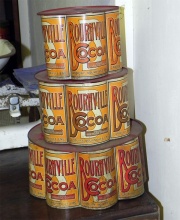Cadbury Brothers: Difference between revisions
No edit summary |
No edit summary |
||
| Line 57: | Line 57: | ||
[[image:Im19531003Pic-Cadbury2.jpg|thumb| October 1953. ]] | [[image:Im19531003Pic-Cadbury2.jpg|thumb| October 1953. ]] | ||
[[Image:Im19531024PP-Cad.jpg|thumb| October 1953.]] | [[Image:Im19531024PP-Cad.jpg|thumb| October 1953.]] | ||
[[Image:Im19531212PP-Cad.jpg|thumb| December 1953. ]] | |||
[[Image:Im195407GHK-Cadbury.jpg|thumb| July 1954. ]] | [[Image:Im195407GHK-Cadbury.jpg|thumb| July 1954. ]] | ||
[[image:Im196311HG-Bournville.jpg|thumb| November 1963.]] | [[image:Im196311HG-Bournville.jpg|thumb| November 1963.]] | ||
Revision as of 08:47, 24 October 2011






















































of Bournville, Birmingham. (1929)
Ditto Address. Telephone: Birmingham, Kings Norton 2000. Cables: "Cadbrofry, Birmingham". London showrooms, Botolph House, 10 and 12 Eastcheap, London, EC3. Telephone: Avenue 2161. (1947)
In 1824, John Cadbury began vending tea, coffee, and (later) chocolate at Bull Street in Birmingham, and sometime in India. Soon a new sideline was introduced - cocoa and drinking chocolate, which he prepared himself using a mortar and pestle. The company was then known as Cadbury Brothers.
1847 A larger factory was rented in Bridge Street, off Broad Street, in the centre of Birmingham. John Cadbury took his brother Benjamin into partnership and the family business became Cadbury Brothers of Birmingham.
1850 Son Richard Cadbury joined the firm.
1850s Taxes on imported cocoa beans were reduced by the Prime Minister, Gladstone. This was a turning point for the cocoa and chocolate industry, bringing these products within the reach of a wider section of the population.
1854 Cadbury Brothers received their first Royal Warrant on February 4, as 'manufacturers of cocoa and chocolate to Queen Victoria.
1856 Second son George Cadbury joined the company.
1861 John Cadbury retired due to failing health; his sons George and Richard taking over the cocoa factory.
1879 John Cadbury's sons opened a major factory in the purpose-built suburb of Bournville, four miles south of the city.
1889 John Cadbury died.
1899 Richard Cadbury died at the age of 63 and the business became a private limited company: Cadbury Brothers Limited. The Bournville factory had trebled in size, with more than 2,600 employees.
- 1900 George Cadbury founded Bournville Village Trust. This included 330 acres of land, providing spacious and sanitary houses.
- 1910 The number of employees at Bournville had grown to 5,300.
- 1911 All workers, men and women, were given holidays with pay and included in the company pension scheme.
- 1912 Became a public company.
- 1913 A second factory was set up in Gloucestershire. This meant that both factories were situated by canals, ensuring economical transportation.
- 1916 Cadbury took over Fry's. Fry's had been the market leader for the whole of the 19th Century and dated back to 1756, when Joseph Fry set up business as an apothecary and maker and seller of chocolate.
- 1916 Introduced Milk Tray.
- 1919 Company became British Cocoa and Chocolate with a capital of £2.5 million. [1]
- WWI. Over 2,000 male employees joined the armed forces and Cadbury sent books, warm clothes and chocolate to the front. Cadbury even augmented the Government allowances to its workers' dependants. At the end of the war soldiers were taken care of: returning to work; being sent on educational courses; or being looked after in convalescent homes.
- 1922 George Cadbury died.
- 1929 Listed Exhibitor - British Industries Fair. Manufacturers of Cocoa, Chocolate and Confectionery. A special display of the most popular of Cadbury's Chocolates for home and export as well as interesting new lines. Also a display of Bourniville Cocoa. 'Cups of this beverage will be sold at 1d. (<½p) each'. [2]
- 1933 Whole Nut bar introduced.
- 1938 At Bournville alone, 10,000 men and women were employed.
- WWII. Cadbury contributed to the war effort in many ways, from converting parts of the factory to workrooms (manufacturing all kinds of equipment such as milling machines for rifle factories) to the production of pilots seats for Defiant fighters.
- 1947 Listed Exhibitor - British Industries Fair. Manufacturers of Cocoa, Bournvita, Chocolate, Chocolate Confectionery, Chocolate Biscuits. (Earls Court, 1st Floor, Stand No. 583) [3]
- 1950 Advert on this page for Bourn-vita. [4]
- 1959 Introduced the Picnic bar.
- 1961 Subsidiary of British Cocoa and Chocolate Co Ltd. Employed 23,500 persons in the group. Works at Bournville, Birmingham. [5]
- 1969 Merged with Schweppes.
See Also
Sources of Information
- ↑ Trademarked. A History of Well-Known Brands - from Aertex to Wright's Coal Tar by David Newton. Pub: Sutton Publishing 2008 ISBN 978-0-7509-4590-5
- ↑ 1929 British Industries Fair p34
- ↑ 1947 British Industries Fair p53
- ↑ [1] History World
- ↑ 1961 Guide to Key British Enterprises

